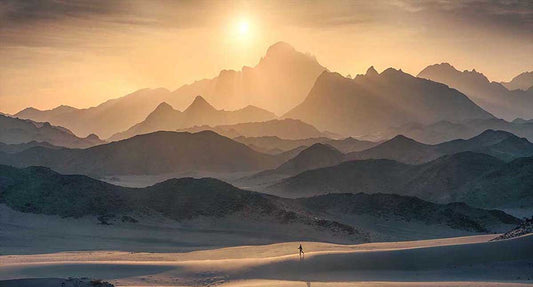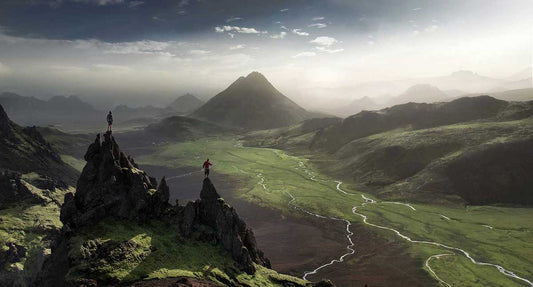In this Ultimate Photography to Lauterbrunnen we will cover everything you need to know about the area and prepare before you visit from the how to get there, best shooting spots, the seasons, gear recommendations and some personal highlights from one of my favorite portfolio images taken in Lauterbrunnen.
Where is Lauterbrunnen
Lauterbrunnen is a small Swiss mountain village located in the canton of Bern – near Interlaken. Above this village, you’ll find many stunning mountains, such as the Eiger, Mönch, and Jungfrau. All of these peaks rise above 4,000 meters.
Directly above the village is the Staubbachfall, one of the features that makes this location such a great photo spot. At 297 meters high, it is the third-highest waterfall in Switzerland and the highest free-falling waterfall in Europe (although there's some debate about whether it truly fits that category – don’t ask me why).
Pictured here is Stabbachfall in summer 2016.
The Staubbachfall isn’t the only waterfall here. There are two more spectacular ones: the Buchenbachfall and the Spissbachfall.
The valley is known for its sheer vertical rock walls near the valley floor, with steep, forest-covered slopes rising above. It was shaped by glaciers during the Ice Age.
Best Photo Spots Around Lauterbrunnen
The best photo spot is above the valley, near the village of Wengen (at 1,274 meters). From here, you can see the three waterfalls: the Buchenbachfall, the Spissbachfall, and the Staubbachfall (from left to right – or from farthest to nearest). You can also see the 4,164-meter-high Breithorn in the middle of the far distance.
On the left, you can see the Schwarzmönch mountain with its vertical mountain walls. This mountain is only 2,649 meters high – with the Jungfrau (4,158 meters – not visible in photos from Wengen) directly above it. The shape of this relatively low-elevation mountain looks very spectacular and frames the scene on the left side.
Buchenbachfall, Spissbachfall, and Staubbachfall from left to right.
Tripods are very useful for aligning your shots, which is crucial for seamless panoramas (more on alignment soon). However, they’re not absolutely necessary. A steady hand—or even creatively balancing your camera on your knees—can also do the trick.
For those who want to get technical, optional gear includes a panoramic head for precise camera rotation, this is a specialized tripod accessory for a camera that allows for precise rotation around the lens's. By ensuring the camera pivots around this optical center, it enables photographers to capture a series of overlapping images that can be stitched together by software into a single, seamless panorama. A bubble level or in-camera leveling tools to ensure stability, and a remote shutter release to reduce camera shake. While these tools aren’t required, they can help achieve more precise alignment and sharper images. Personally, I don’t use any of these, but many photographers find them helpful.
It is the combination of the three waterfalls and the steep vertical mountain walls on that side that makes this photo so spectacular and unique. The Breithorn adds symmetry to the composition, and the Schwarzmönch keeps the eye inside the frame. On top of that, the green alpine meadows and rolling hills seen from the Wengen side add to the fairy tale-like scene.
Best Photography Season
The Waterfall
Because the location is so special due to its waterfalls (the Buchenbachfall, the Spissbachfall, and the Staubbachfall), you need to visit in a season when the waterfalls are at their best. This generally rules out the winter season, as there is less melting water due to the cold, and most precipitation falls as snow at higher elevations.
Spring is the season when melting snow creates the largest waterfalls. However, the snow on top of the mountains can make the image look a bit messy and can take away from the green tones of the forest.
Summer offers better colors, with less snow on the mountains above the waterfalls. The image has more vibrant tones in summer. You’ll also experience more dramatic weather, with possible rain showers and clear spells. One challenge in summer can be periods of drought combined with reduced snowmelt. This can occur in the second half of July – though the amount of snow and the timing of summer can vary each year.
In fall, there is almost no snowmelt, and the amount of water in the waterfalls depends entirely on rainfall.
Spring in Lauterbrunnen from my favourite viewpoint 2018.
The Light
The best light is in autumn and winter. This is because you are looking towards the south. In summer and spring, the sun rises in the northeast and sets in the northwest. This creates light that can be a bit flat. In late summer and early spring, the sun rises and sets more in an eastern and western direction – creating more depth in the image.
Especially when you have dramatic weather, you can already shoot when the sun is still high in the sky. In autumn and winter, there is more depth in the valley because the sun is more in the frame. You can shoot during both sunrise and sunset.
At sunrise, the light comes from the left and hits the waterfalls at some point. The problem with sunrise can be the line between shadow and light – creating a hard contrast between sun and shadow. A mix of sun and clouds is needed to create softer light.
At sunrise, the light comes from the left and hits the waterfalls at some point. The problem with sunrise can be the line between shadow and light – creating a hard contrast between sun and shadow. A mix of sun and clouds is needed to create softer light.
At sunset, the sun no longer hits the waterfalls, but it can create nice depth in the valley. Even when the waterfalls are in shadow, they can still stand out and look dramatic.
For the best light, my recommendation is to shoot this place during sunrise in the fall and winter seasons – followed by mid to late summer.
Autumn colours over Lauterbrunnen in 2019.
The colors
In summer and spring, the colors are green. You have the green rolling hills in the foreground and the dark greens in the trees. Flowers are difficult to find on the alpine meadows (with a view), because the grass is cut regularly. However, it is always worth exploring different areas each season, since every year can be different.
In autumn and fall, the chances of finding flowers are close to zero. The fall colors are there, but most trees in the distance stay green because of all the pine trees. Lower in the valley, you will find better fall colors, but the view here is simply not the best (unless you like to include all the houses, ski lifts, and whatnot in your frame).
In winter, snow can create a nice mood. Even though I think it’s the green fields that make the image so special. For me, summer wins – since the fall colors are not that strong.
Drones
Unfortunately, flying a drone in the Lauterbrunnen area is not allowed. However, you can still capture aerial views — for example, by paragliding, small plane, or helicopter.
Night Photography Lauterbrunnen
Most photos you see are taken during daylight – or better, almost all photos! You can, of course, take a night photo, but is it any good? See the result here:
The difficulty of taking a night photo in Lauterbrunnen is the light pollution from the village/town. The light is not only in the valley, but it also hits the mountain walls around it. This can actually give a nice effect, as long as the light and color are adjusted in post. The lights in the town are more difficult to deal with. The best way to handle this is to shoot as late as possible, when most lights are out. Still, you have to deal with street lights, so don’t expect total darkness by any means.
Besides shooting late at night, there’s another way to make the light pollution less present: shoot during moonlight. The intensity of the lights is reduced. Of course, the night sky won’t show as many stars, but for me, it’s all about the mood of the light. In such a case, you can block the moonlight with a tree to create a moonstar. The river in the valley will also reflect some of the moonlight.
Camera Gear
Gear is relatively simple, a wide-angle lens — ideally between 18mm and 30mm — is best for shooting Lauterbrunnen. If you use too much zoom, you’ll lose one of the key elements.
How To Get to the Viewpoint Above Lauterbrunnen
Hiking
You can best park your car at the Parkplatz Lauterbrunnenn Kirche:
This parking lot often has plenty of spots — but keep in mind that during peak season (July and August), it can fill up quickly. Also note that this parking is not free (like almost anywhere in Switzerland). Another option is the parking garage you can find here: 46° 35' 54" N 007° 54' 32" E
From either of these locations you can hike towards the following spot: 46°35'51.8"N 7°54'47.9"E
This spot is the beginning of the trail up to Wengen. The hike takes around 30 min to 1 hour - depending on fitness level. Keep in mind you don't want to go all the way up to Wengen to take the best photos. When you reach the following spot you have arrived in a good area from which you can shoot and explore: 46°35'54.6"N 7°54'32.8"E
You can also make use of online hiking maps and apps to help you with navigation. There are many websites with detailed maps you can use for free such as Map Wanderland. When you open the website, you can zoom in to Lauterbrunnen. Another and probably easier option is to simply type in Lauterbrunnen in the upper left corner. There are also apps such as komoot and Alltrails which have a map. These maps are not as detailed as the online hiking maps so it is best to use a combination of both.
Train
Another option is to take the train from Lauterbrunnen to Wengen. You can go all the way to Wengen and then hike down, or you can get off the train one stop before the end station. This stop is called Wengwald. From here, you have various small roads and trails going down the mountain. You are already in the shooting area as soon as you leave Wengwald — no need to hike much further down.
There are trains every 30 minutes from Lauterbrunnen Bahnhof. It takes around 13 minutes to reach the end station and 10 minutes to reach Wengwald. A single ticket costs around 7.20 Swiss francs at the time of writing. A return ticket from Lauterbrunnen to Wengen costs around 13 Swiss francs.
Lauterbrunnen in summer months.
The Story Behind My Best Lauterbrunnen Photo
I packed my food — or at least what was left of it, since I often eat 80% of my trail snack supplies in the car — my rain jacket, umbrella, and of course my camera gear. I started at the Lauterbrunnen Kirche parking and was happy to burn off the calories (and get some photos). I decided to go all the way up to the Männlichen mountain, which is very high above Lauterbrunnen.
After around 30 minutes of hiking up the mountain, the clouds became darker. Even though this was already predicted, I decided to stop and sit out the first rain showers. I could hear thunder approaching from a distance — something I never enjoy when being in the mountains, or better said, I’m scared shitless of thunder!
The weather then became pretty bad and it didn’t look very promising. Just when I wanted to head all the way back down to the parking after taking shelter in a Swiss restaurant, a slight warm color became visible in the sky. It slowly became clear to me (and also above my head) that I had to get ready for an epic sunset.
The only problem was... I didn’t have any composition ready. As every landscape photographer knows, there is nothing worse than having great conditions but not having the shot. I had shot the viewpoint around Wengen before, but that was with my tele-lens and without any foreground. I quickly moved around in search of something.
Still powered by all the trail snacks I had eaten some hours before, I ran around looking for flowers, streams, framings with trees, but nothing was worthy of a portfolio shot — until I saw a herd of sheep grazing in the distance. When I came closer, I also noticed a really nice midground. The only thing that was lacking was good separation between the trees.
I noticed that the clouds in the valley moved upwards towards... ME! I was already almost continuously shooting at that time. The mist came, the sheep kept eating their grass, and I kept shooting until I got my banger shot.
This picture was taken in 2022.
The shot itself was pretty easy with only a 2-shot focus stack. The light was incredible, with a soft warm glow in the distance and lots of depth thanks to the mist at different elevations. I used my Nikon D810, the Tamron 15-30mm lens, and shot this photo at 25mm. I didn’t use a tripod. Other settings were f/13, 1/20 of a second, and ISO 200. No tripod used — this would have slowed me down too much and probably made me miss this shot.
Final Thoughts
Despite Lauterbrunnen being a very touristy spot, the photography areas I’ve included in this guide are much quieter, giving you a great chance to capture really unique shots. Keep in mind the importance of lighting and seasonal colors—and most importantly, enjoy your trip exploring Lauterbrunnen! If you have any questions, let me know in the comments below.
Max Rive is most driven by seeking new perspectives in the natural world and capturing them in his own distinguished style. Max's powerful portrayals of his interactions with the mountains has earned him international recognition in the outdoor community.
Madison McCardle is a passionate landscape photographer driven by curiosity and a desire to capture the true essence of each place she explores. Through her lens, she seeks new perspectives that reveal the beauty and authenticity of the world.
✉️ JOIN US TODAY
Don't miss out on wallpapers, E-books and tour announcements!
DISCUSSION
LEAVE A COMMENT
Your Email Address Will Not Be Published. Required Fields Are Marked *
































No comments